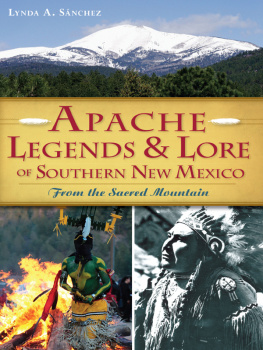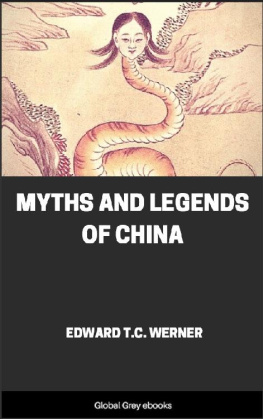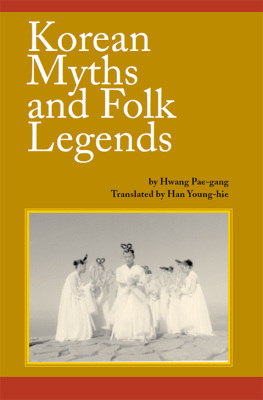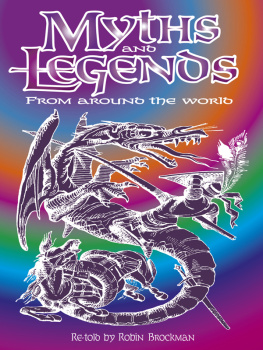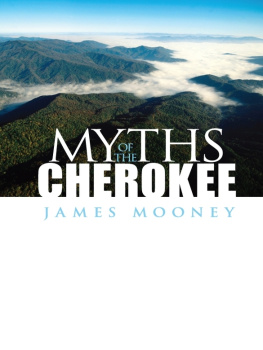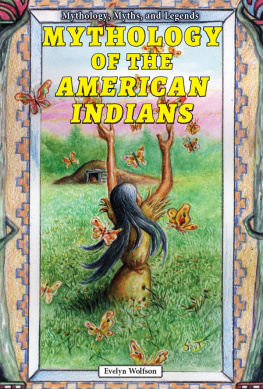This edition is published by BORODINO BOOKS www.pp-publishing.com
To join our mailing list for new titles or for issues with our books borodinobooks@gmail.com
Or on Facebook
Text originally published in 1940 under the same title.
Borodino Books 2018, all rights reserved. No part of this publication may be reproduced, stored in a retrieval system or transmitted by any means, electrical, mechanical or otherwise without the written permission of the copyright holder.
Publishers Note
Although in most cases we have retained the Authors original spelling and grammar to authentically reproduce the work of the Author and the original intent of such material, some additional notes and clarifications have been added for the modern readers benefit.
We have also made every effort to include all maps and illustrations of the original edition the limitations of formatting do not allow of including larger maps, we will upload as many of these maps as possible.
MYTHS AND LEGENDS OF THE LIPAN APACHE INDIANS
BY
MORRIS EDWARD OPLER
PREFACE
The myths and tales of this volume are of particular significance, perhaps, because they have reference to a tribe about which there is almost no published ethnographic material. The Lipan Apache were scattered and all but annihilated on the eve of the Southwestern reservation period. The survivors found refuge with other groups, and, except for a brief notice by Gatshet, {1} they have been overlooked or neglected while investigations of numerically larger peoples have proceeded. It is gratifying, therefore, to be able at this late date to present a fairly full collection of Lipan folklore, and to be in a position to report that this collection does much to illuminate the relations of Southern Athabaskan-speaking tribes and the movements of aboriginal populations in the American Southwest.
Before the beginning of the 18 th century the Lipan were already in the northern part of the present state of Texas, {2} and were being forced southward by hostile Comanche. By the middle of the 18 th century we find them in south central Texas, where the Spaniards sought to protect them from their persistent enemies by the erection of the Mission of San Sab. {3} Following the destruction of this mission, two others were established to the south and west to administer to these Apache. They met a like fate in 1767. In 1796 the Lipan are reported to have reached the Gulf Coast in the vicinity of the lower Rio Grande. {4} For the next half century they lived on or in the vicinity of the coast and made a partial adjustment to that environment. The hostilities between the Texans and Mexicans during the last part of this period involved the Lipan as allies of the latter. Then part of the Kickapoo, who had ceded their lands in Illinois, invaded Texas and were added to the list of Lipan enemies. A serious epidemic of smallpox decimated the tribe further. The Lipan, wasted by warfare and disease, were forced northward and westward. Part of them found a retreat in the southern spurs of the Guadalupe Mountains, where they made contact with the southernmost settlements of the Mescalero Apache. These people, whom I have called the Northern Lipan in the tales, have become known as the No Water People. Another section of the tribe crossed the Rio Grande and settled in the neighborhood of Zaragoza, Coahuila. I place the date of the permanent removal of these Lipan to Old Mexico (raiding expeditions had penetrated into Old Mexico on previous occasions, of course) at about 1860 or shortly thereafter. This section of the tribe, the Southern Lipan of the tales, has become known as the Big Water People. The Big Water People, because their fate has been less involved with that of the Mescalero Apache until quite recently, are prone to consider themselves the true representatives of Lipan culture. {5}
From 1860 on the Northern Lipan became increasingly amalgamated with the Mescalero. When attempts were made to concentrate the Mescalero at Ft. Stanton in 1870, many Lipan were gathered into the net. At this same time the Southern Lipan were having difficulty with the Mexican military and a group of them were happy to find protection to the north. Thus it was that in 1903, when a handful of Lipan who had survived a war of extermination which had been waged against them in Coahuila, were brought to Chihuahua, it became known that they had relatives on the Mescalero Reservation. Efforts were made to unite them with their kin living in the United States. In that year a small band of nineteen individuals was brought to Mescalero. This event has given rise to the impression that the Lipan were never anything more than an offshoot of the Mescalero tribe whose members somehow became separated from the main group and who were finally restored to their relatives.
Evidence is accumulating which suggests a different historical origin and other ethnic relationships for the Lipan, however. In an analysis of Southern Athabaskan kinship systems {6} I have tried to show that the Lipan system resembles the Jicarilla and not the Chiricahua-Mescalero type, and that Lipan kinship stands closer to Jicarilla in respect to form, terms, and behavior patterns than to kinship usages of any other Southern Athabaskan-speaking tribe. Dr. Harry Hoijers scholarly analysis of the relationship of Southern Athabaskan languages demonstrates that Jicarilla and Lipan together constitute a sub-group of the eastern linguistic group, quite apart from Mescalero, which is classified in the other or western group. {7} The conclusion seems inescapable that the affiliation of the Lipan and Mescalero is a recent and secondary one and that more ancient and fundamental connections must be sought to the north.
It is of interest and importance to consider whether the myths and tales yield materials which offer further insight concerning the place of the Lipan in Southwestern cultures. The results of such an inquiry have proved so gratifying that it is doubtful whether the value of mythology for purposes of ethnological analysis has ever been better vindicated.
A glance at the table of contents of this volume is enough to reveal one of the major differences in myth and conception which divides the Lipan from the Mescalero; the Lipan have a myth of emergence. This gives a definite cast to Lipan mythology which Mescalero mythology does not share, for a number of other Lipan stories take their inspiration from events which transpired in the underworld before the emergence (Section I, C). The myths of all Southern Athabaskan tribes (with the possible exception of the Kiowa Apache) include a story of a culture hero who slew the foes of the race. The Navaho, Western Apache, and Jicarilla name the chief protagonist Killer-of-Enemies and have him attended by a subordinate (a younger brother, relative, or friend) who is ordinarily known as Child-of-the-Water. By a curious twist the Mescalero and Chiricahua have just reversed the positions of these two; for them Child-of-the-Water becomes the intrepid hero and monster slayer and Killer-of-Enemies his weaker companion. The Lipan lean towards the northern and western usage. Killer-of-Enemies is their culture hero. They use the term Child-of-the-Water seldom, and then only as a synonym for Killer-of-Enemies. In the Lipan tales a younger brother of the culture hero called Wise One appears, and to him are attributed the characteristics usually associated with the less important of the divine pair.




